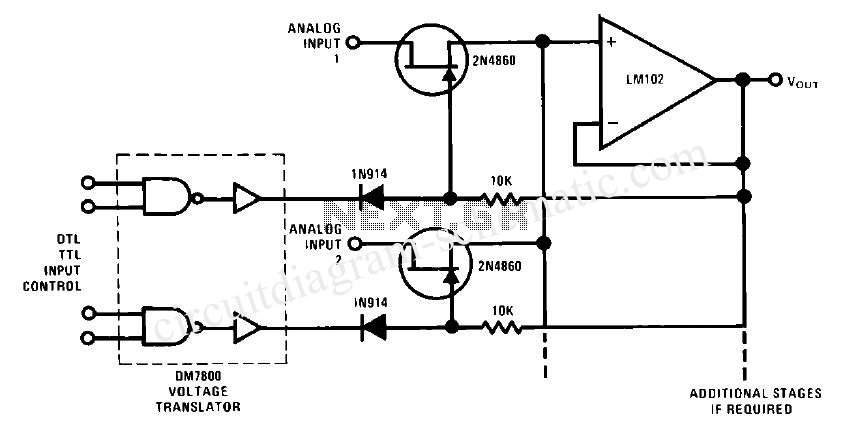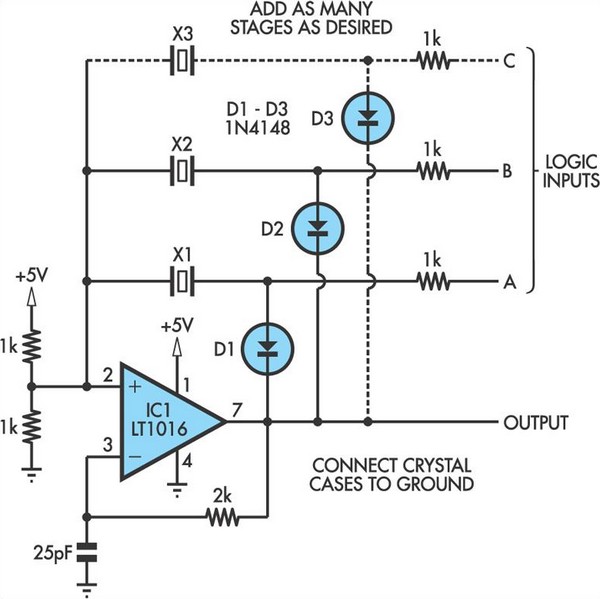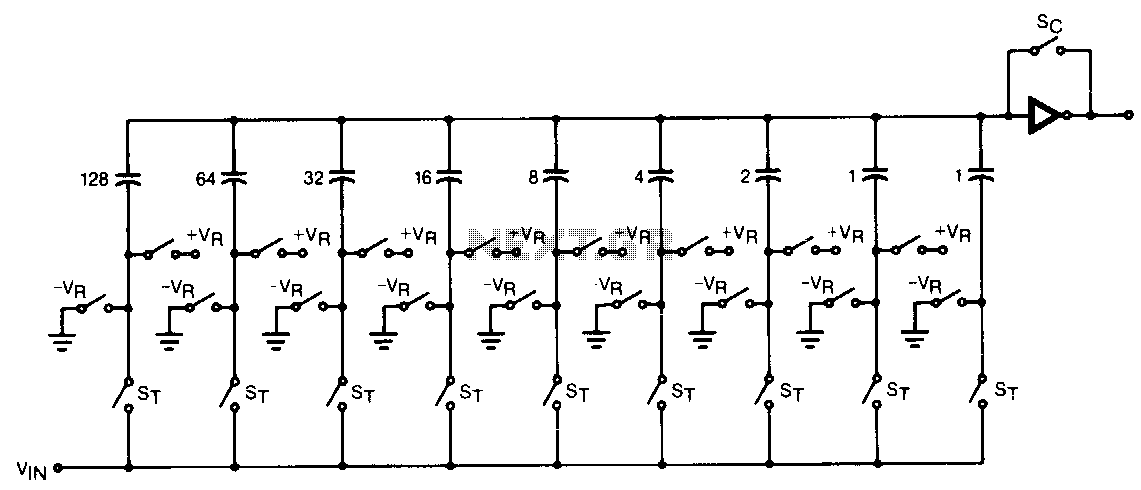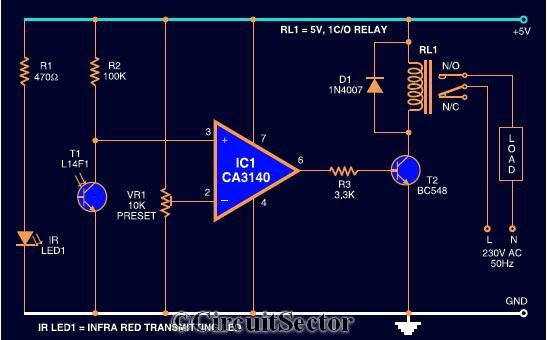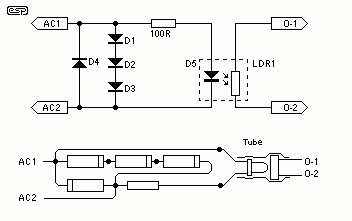
CMOS Toggle Flip Flop Switch

The circuit below uses a CMOS dual D flip flop (CD4013) to toggle a relay or other load with a momentary push button. Several push buttons can be wired in parallel to control the relay from multiple locations. A high level from the push button is coupled to the set line through a small (0.1uF) capacitor. The high level from the Q output is inverted by the upper transistor and supplies a low reset level to the reset line for about 400 mS, after which time the reset line returns to a high state and resets the flip flop. The lower flip flop section is configured for toggle operation and changes state on the rising edge of the clock line or at the same time as the upper flip flop moves to the set condition. The switch is debounced due to the short duration of the set signal relative to the long duration before the circuit is reset. The Q or Qbar outputs will only supply about 2 mA of current, so a buffer transistor or power MOSFET is needed to drive a relay coil, or lamp, or other load. A 2N3904 or most any small signal NPN transistor can be used for relay coil resistances of 250 ohms or more. A 2N3053 or medium power (500 mA) transistor should be used for coil resistances below 250 ohms. The 47 ohm resistor and 10uF capacitor serve to decouple the circuit from the power supply and filter out any short duration noise signals that may be present. The RC network (.1/47K) at the SET line (pin 8) serves as a power-on reset to ensure the relay is de-energized when circuit power is first applied. The reset idea was suggested by Terry Pinnell who used the circuit to control a shed light from multiple locations.
The circuit employs a CMOS dual D flip-flop (CD4013) configured to toggle a relay or load in response to a momentary push button input. The use of CMOS technology allows for low power consumption and high noise immunity. The momentary push button provides a high signal that is coupled to the set line of the flip-flop through a 0.1 µF capacitor, which serves to filter any rapid fluctuations in the signal, effectively debouncing the switch.
When the push button is pressed, the set line receives a high signal, causing the flip-flop to set its Q output high. This high signal is then inverted by a transistor, which pulls the reset line low for approximately 400 milliseconds, allowing the circuit to stabilize before the reset line returns to a high state. This timing ensures that the flip-flop is reset after a brief period, preventing unintended toggling.
The lower section of the flip-flop is configured to toggle its state on the rising edge of the clock signal. This configuration allows the circuit to maintain its state until the next push button press, thereby enabling multiple push buttons wired in parallel to control the relay from various locations.
Due to the limited current output of the Q and Qbar (approximately 2 mA), an additional buffer transistor or power MOSFET is necessary for driving larger loads, such as relay coils or lamps. For loads with resistance greater than 250 ohms, a small-signal NPN transistor like the 2N3904 is suitable. For lower resistance loads, a medium power transistor like the 2N3053 should be utilized to handle the increased current demand.
The circuit is further stabilized by a 47-ohm resistor and a 10 µF capacitor, which work together to decouple the circuit from the power supply and filter out noise. An RC network comprising a 0.1 µF capacitor and a 47 kΩ resistor at the SET line provides a power-on reset feature, ensuring that the relay remains de-energized immediately upon powering the circuit. This design enhances reliability and usability, making it an effective solution for controlling loads from multiple locations.The circuit below uses a CMOS dual D flip flop (CD4013) to toggle a relay or other load with a momentary push button. Several push buttons can be wired in parallel to control the relay from multiple locations. A high level from the push button is coupled to the set line through a small (0.1uF) capacitor. The high level from the Q output is inverted by the upper transistor and supplies a low reset level to the reset line for about 400 mS, after which time the reset line returns to a high state and resets the flip flop.
The lower flip flop section is configured for toggle operation and changes state on the rising edge of the clock line or at the same time as the upper flip flop moves to the set condition. The switch is debounced due to the short duration of the set signal relative to the long duration before the circuit is reset. The Q or Qbar outputs will only supply about 2 mA of current, so a buffer transistor or power MOSFET is needed to drive a relay coil, or lamp, or other load.
A 2N3904 or most any small signal NPN transistor can be used for relay coil resistances of 250 ohms or more. A 2N3053 or medium power (500 mA) transistor should be used for coil resistances below 250 ohms. The 47 ohm resistor and 10uF capacitor serve to decouple the circuit from the power supply and filter out any short duration noise signals that may be present.
The RC network (.1/47K) at the SET line (pin 8) serves as a power-on reset to ensure the relay is denergized when circuit power is first applied. The reset idea was suggested by Terry Pinnell who used the circuit to control a shed light from multiple locations.
🔗 External reference
The circuit employs a CMOS dual D flip-flop (CD4013) configured to toggle a relay or load in response to a momentary push button input. The use of CMOS technology allows for low power consumption and high noise immunity. The momentary push button provides a high signal that is coupled to the set line of the flip-flop through a 0.1 µF capacitor, which serves to filter any rapid fluctuations in the signal, effectively debouncing the switch.
When the push button is pressed, the set line receives a high signal, causing the flip-flop to set its Q output high. This high signal is then inverted by a transistor, which pulls the reset line low for approximately 400 milliseconds, allowing the circuit to stabilize before the reset line returns to a high state. This timing ensures that the flip-flop is reset after a brief period, preventing unintended toggling.
The lower section of the flip-flop is configured to toggle its state on the rising edge of the clock signal. This configuration allows the circuit to maintain its state until the next push button press, thereby enabling multiple push buttons wired in parallel to control the relay from various locations.
Due to the limited current output of the Q and Qbar (approximately 2 mA), an additional buffer transistor or power MOSFET is necessary for driving larger loads, such as relay coils or lamps. For loads with resistance greater than 250 ohms, a small-signal NPN transistor like the 2N3904 is suitable. For lower resistance loads, a medium power transistor like the 2N3053 should be utilized to handle the increased current demand.
The circuit is further stabilized by a 47-ohm resistor and a 10 µF capacitor, which work together to decouple the circuit from the power supply and filter out noise. An RC network comprising a 0.1 µF capacitor and a 47 kΩ resistor at the SET line provides a power-on reset feature, ensuring that the relay remains de-energized immediately upon powering the circuit. This design enhances reliability and usability, making it an effective solution for controlling loads from multiple locations.The circuit below uses a CMOS dual D flip flop (CD4013) to toggle a relay or other load with a momentary push button. Several push buttons can be wired in parallel to control the relay from multiple locations. A high level from the push button is coupled to the set line through a small (0.1uF) capacitor. The high level from the Q output is inverted by the upper transistor and supplies a low reset level to the reset line for about 400 mS, after which time the reset line returns to a high state and resets the flip flop.
The lower flip flop section is configured for toggle operation and changes state on the rising edge of the clock line or at the same time as the upper flip flop moves to the set condition. The switch is debounced due to the short duration of the set signal relative to the long duration before the circuit is reset. The Q or Qbar outputs will only supply about 2 mA of current, so a buffer transistor or power MOSFET is needed to drive a relay coil, or lamp, or other load.
A 2N3904 or most any small signal NPN transistor can be used for relay coil resistances of 250 ohms or more. A 2N3053 or medium power (500 mA) transistor should be used for coil resistances below 250 ohms. The 47 ohm resistor and 10uF capacitor serve to decouple the circuit from the power supply and filter out any short duration noise signals that may be present.
The RC network (.1/47K) at the SET line (pin 8) serves as a power-on reset to ensure the relay is denergized when circuit power is first applied. The reset idea was suggested by Terry Pinnell who used the circuit to control a shed light from multiple locations.
🔗 External reference
